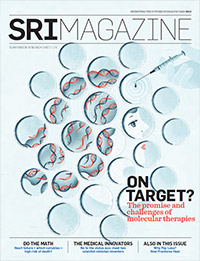Features
Messages
Digest
Short Stories
Why Pay Less?
Snapshot
How Canada stack ups against the U.S. and the average across the 34 Organisation for Economic Co-operation and Development (OECD) countries when it comes to health care
Overall health spending per capita ($USD)

Number of magnetic resonance imaging scanners in hospitals

Average life expectancy (years)

Obesity rate among adults (%)
Rates of obesity are rising among OECD countries, and this condition is set to put serious strain on future health care spending, owing to its association with serious health conditions like diabetes and heart disease.

* Based on the 29 OECD countries with data
^ Based on the 22 OECD countries with data
* * Based on the 15 OECD countries with data
Source: OECD Health Data 2012.
Quality health care doesn't come cheap, says research that links hospital spending with outcomes—but there's more to it than dollars in, care out
Everyone loves a bargain, but sometimes you get what you pay for; it's an old adage, and usually true, except if the "product" in question is hospital-delivered care.
When it comes to health care, "it's not how much you spend, it's how you spend it," says Dr. Thérèse Stukel, a scientist in health services and policy at Sunnybrook Research Institute.
In a provincial study on hospital spending, Stukel and colleagues investigated whether seriously ill hospitalized patients who were admitted to higher-spending hospitals in Ontario received better quality of care and had better outcomes compared with patients admitted to hospitals that spend less.
They did.
The study assessed patients admitted to hospital for the first time with a heart attack, congestive heart failure, a hip fracture or colon cancer between 1998 and 2008. Results showed patients in higher-spending hospitals had lower rates of death and readmission, fewer repeat cardiac events and higher quality of care. The paper was published in the Journal of the American Medical Association in 2012.
Stukel examined Ontario's health care system, which, unlike that of the U.S., has global hospital budgets, selective access to medical technology, and fewer specialists and specialized services. Hospital spending was categorized into low, medium or high. Total costs related to study patients were measured for all hospital, emergency department and physician services over one year following patients' date of admission, averaged to the hospital level and attributed to the index hospital of admission. This measures the intensity of a hospital's medical spending—how resources are spent on similarly ill patients—during the year, based on the average adjusted spending for hospital, emergency department and physician services.
"We basically saw that hospital spending varied by twofold across hospitals for similarly ill patients," says Stukel, who is also a scientist at the Institute for Clinical Evaluative Sciences. "Highest-spending hospitals spent twice as much in one year than the lowest-spending hospitals."
Spending intensity for the acute care index ranged from $19,300 to $32,580 per study patient over the year.
Stukel found that higher-spending hospitals in Ontario were typically large teaching or community hospitals located in urban areas, and were associated with regional cancer centres. They offered specialized services, such as onsite cardiac catheterization (an advanced procedure where a catheter is inserted into the heart to diagnose or treat heart conditions), cardiac surgery and diagnostic imaging, including computed tomography (CT) and magnetic resonance imaging (MRI). These hospitals also had more nursing staff, who provided, on average, 30% more inpatient nursing hours. Attending physicians were more likely to be specialists or general internists who treated high volumes of these conditions.
Moreover, patients admitted to higher-spending hospitals had longer stays and were less likely to be admitted to an intensive care unit. They also had more visits from medical specialists while in hospital, and cardiac patients were more likely to receive cardiac interventions and medications.
"What's driving some of the spending is that everyone wants access to more high-tech services [such as] diagnostic testing, and equipment is getting more expensive and complicated," Stukel says. "These are things that are not exported easily to a low-spending, small, rural hospital."
Yet, it's not just about access to higher-cost or more resources. In a similar study Stukel and colleagues conducted a decade ago examining the U.S. health care system, they found that greater hospital spending in the U.S. did not lead to better patient outcomes.
"The U.S. is the highest spender on health care," Stukel says. "They spend 50% to 60% more per capita than anybody in the world."
She says that despite "scarce resources" in this country, Canada is spending more efficiently and effectively on its health care system than is the U.S. Accordingly, she cautions that the results of this study do not imply that spending more will lead to better patient outcomes.
"The public needs to understand that it's not just about infusing more money into the health care system. We need to spend resources wisely and where it provides benefit to patients," she says. "There's a limit to how much health you can buy with more spending, and it can have a marginally small effect on outcome improvement."
Stukel's research was funded by the Canadian Institutes of Health Research, the U.S. National Institute on Aging, and the Ontario Ministry of Health and Long-Term Care.
—Eleni Kanavas

- << Features |
- Previous: Do the Math •
- Next: The Medical Innovators
- |Messages >>




